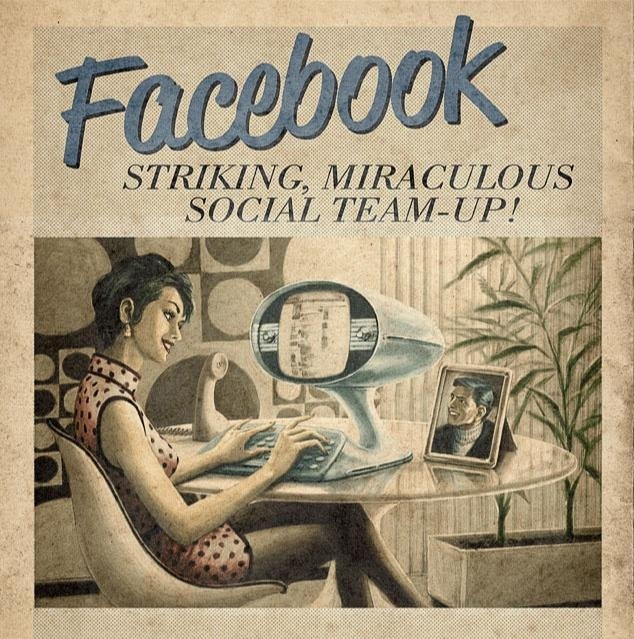
Advertising on social media has grown astronomically in a very short period of time. Considering it didn't even exist ten years ago (the first social media ad was released on Facebook in 2004) the estimated $12 billion of revenue it will generate by 2017 is indeed impressive.
But I would argue it's not all that surprising. In its current iteration, social media advertising allows unprecedented audience segmentation and user targeting capabilities, with online messaging distributed to the right people, at the right time. The targeting is granular and the platforms intuitive, leveraging data advertisers of past eras could only dream of. And judging by how quickly social media advertising has been developing, we can expect that it will only become more essential, particularly as networks like LinkedIn and Twitter try and match Facebook's advertising capabilities (they're not quite there yet).
In this month's installment of Throwback Thursdays, we're going to be diving into the development of social media advertising, its benchmarks and milestones, and how it has reached the status it is at today.
Facebook Flyers (2003)
When it was still called TheFacebook, the social media network had very early versions of ads called "Flyers". Locally focused and bought mainly by students and small businesses, they were aimed towards targeting specific campuses. Facebook would later change to a CPC bidding model called "Flyers Pro". These were really the pioneering social media ads, allowing users to set a max price and target based on particular characteristics.
Linkedin Advertising Introduced (2006)
Though LinkedIn was founded way back in 2003, it wasn't until 2006 that they introduced advertising. They were different from other social networks like Facebook and MySpace in that they also charged for premium subscriptions and job classifieds, meaning advertising wasn't their sole means of revenue.
Youtube Ads (2007)
It's no surprise that a video-sharing site would use video ads, but the way YouTube went about it is impressive. They offered pre-roll ads that were shown before the video, as well as the option for viewers to skip the ads to get to their content. While this may seem counterintuitive, it means that advertisers were reaching only those who wanted to watch the ad (and only paying when people watched).
Facebook Steps Up Its Ad Game (2008-2009)
The real catalyst was the introduction of Facebook Pages, which enabled businesses to become publishers on the network, in their own right. With Pages, Facebook created the need for businesses to start promoting their pages (or otherwise spend money) over the network.
Furthermore, Facebook began to significantly refine its targeting options by introducing language and geographically based ad targeting. Page owners could set up and manage their own ads, which they could offer in multiple languages, to people in varying geographic locations. The options available for segmenting and reaching audiences was unprecedented.
Twitter Enters The Advertising Foray (2010)
2010 was a busy year for Twitter. Not only did it release promoted tweets and trends, it also rolled out promoted accounts - ads that invite targeted Twitter users to follow specific brands. With the release of Twitter advertising products, businesses gained the ability to connect with the right users, at the right times.
Facebook Raises The Bar, Again (2011-2013)
In 2011, Facebook introduced Ads APIs, allowing users to create and manage ads on Facebook programmatically. With this move, marketers were given better control and increased capability to create marketing programs over the platform. In the same year, Sponsored Stories were introduced, which show on the News Feed when a user's Friend has some interaction with a Page, app or event. (Facebook recently announced they are eliminating this service).
The most important development in this time frame, however, was the introduction of Facebook mobile ads. Appearing in the News Feed, they pioneered mobile social media advertising, a step that both Twitter and LinkedIn would echo.
During this time, Facebook also introduced the Social Graph, a tool that provides comprehensive user data to advertisers; Facebook Exchange, a real-time bidding tool that allows for cookie-based targeting; and Lookalike Audiences, a service that allows marketers to target profiles for users that are similar to their current customers.
These developments place Facebook well above other networks in terms of advertising offerings, capabilities, targeting and audience segmentation.
Current Social Media Advertising
Every social media advertising breakthrough, development and milestone has culminated to create the highly sophisticated features that marketers enjoy today. Facebook offers Page Promotion, Boosted Posts, Offers, and Ad Creation Tools, with granular, effective targeting options. Twitter allows marketers to reach target audiences via Promoted Accounts, Promoted Tweets, and Promoted Trends. LinkedIn offers exceptional audience targeting performed through both LinkedIn Ads and Sponsored Updates. YouTube provides the ability to target users via the highly effective medium of video.
And given the frenetic pace at which social media advertising has progressed throughout its short existence, it will only become more effective; a prospect that marketers everywhere should be excited about.
